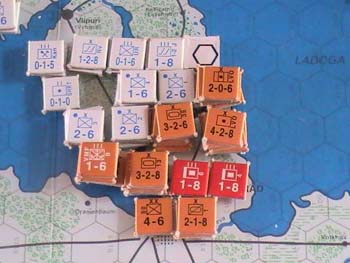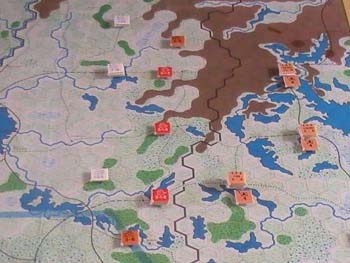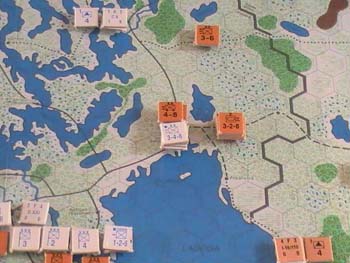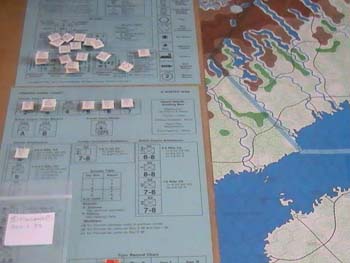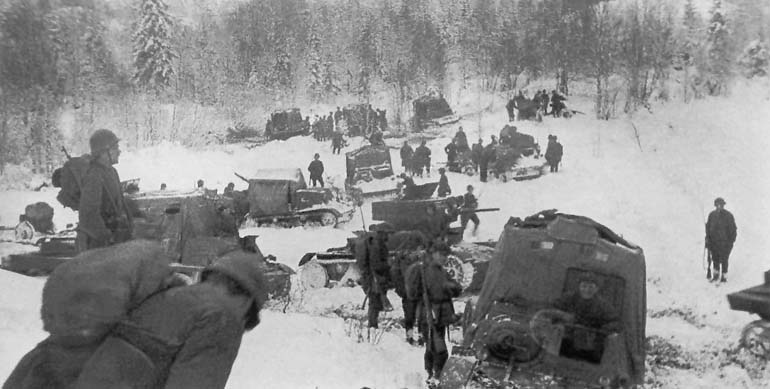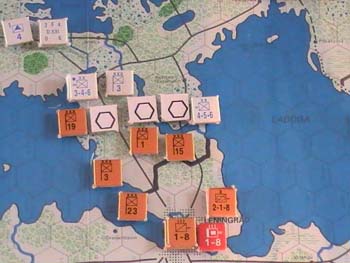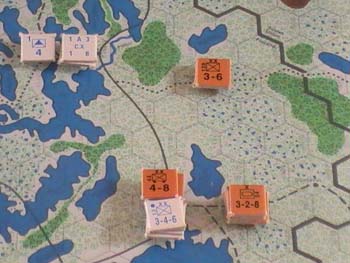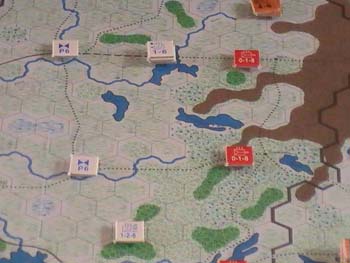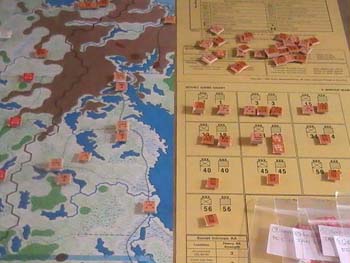Soviet
Order of Battle
Initial
Forces Dec I 1939
All forces are Soviet Regulars unless indicated as:
(f) Soviet Foreign Contingent
(w) Winter-Capable
(NKVD) NKVDInitial
Conditions:
Fortifications: Place in hex 35:4813. 1 x 0-3-0* FAX Kar Rail
Capacity: 15 REs per turn.
Airfields: Place 1 permanent airfield each at Petrozavodsk
(35:4305) and 35:4608. Place one permanent airstrip each at Kandalaksha (35:1504),
Loukhi (35:2104), Ukhta (35:2508), Belomorsk (35:2902), and Medvezhyegorsk (35:3704).
Soviet
Armed Forces
Northwest Front.
Seventh Army. Place
in the Soviet Union within three hexes of the Finnish border from 35:4915 to 35:4713.
2x 5-6 Rifle XX 24, 70
4x 4-6 Rifle XX 43, 90, 123, 138
1x 3-6 Rifle
XX 142 (w)
1x 3-6 Rifle XX 49
2x 3-2-8 Tank X 13, 20
2x 3-2-6 Tank
X 35, 40
1x 1-2-8* Mot MG X 50
1x 1-6 Rifle 111 19
2x 0-1-8 Bdr III
4, 6 (NKVD)
1 x 3-2-8 Art X 7
2x 2-6 Art X 19,50
1x 0-1-5 Cons X 7
1x 1-6 Lt AA III AA=2 7
1x 1-6 Eng III 7
Group Grendal (later
Thirteenth Army). Place in any hexes of Leningrad.
1x 4-6 Rifle XX 50
1x
2-1-8 Lt Tank X 1
1x1-8Cav111 1
Leningrad Military District Reserves.
Stack with any units of the Northwest Front.
1 x 4-2-8 Art X LVO
1x 2-0-6
Siege Art X LVO
I
Northern Front.
Eight Army. Place in
the Soviet Union within three hexes of the Finnish border from 35:4509 to 35:3608.
1x 4-6 Rifle XX 168 (w)
1x 4-6 Rifle XX 18
3x 3-6 Rifle XX 56, 139,
155
1x 3-2-8 Tank X 34
1x 0-1-8 Bdr III 1 (NKVD)
1 x 3-2-8 Art X 8
1
x 1-6 Lt AA III AA=2 8
1x 1-6 Eng 111 8
1x 0-5 Cons 111 8
Ninth
Army. Place in the Soviet Union within three hexes of the Finnish border from
35:3509 to 35:1108.
1 x 4-8 Mot XX 44
2x 4-6 Rifle XX 54, 163
1x 3-6
Rifle XX 122
1x 1-6 Rifle III 88/273 (w)
1x 1-6 Rifle III 529
3x 0-1-8
Bdr III 2, 3, 5 (NKVD)
1x 2-6 Art X 45
1x 1-6 Eng III 9
1x 0-5 Cons III
9
Fourteenth Army. Place in the Soviet Union within five hexes of
Murmansk (35:0701).
2x 4-6 Rifle XX 3, 104 (w)
1x 4-6 Rifle XX 14
Available
Corps HQs (All at their reduced stacking sides).
10x Rifle XXX HQ 1, 3, 15,
19, 23, 34, 40, 45, 50, 56
Soviet Air Force
Up to three air units
may be placed at any airbases in Estonia. Place all remaining air units at any
airbases in the Soviet Union.
1x DB-3b 2133 1-2/39
1 x D B-3t 2B3 2-2/39
1
x G-1 1T1 0/11
1 x G-2 OT2 0/26
2x 1-152 3F2 0/6
4x 1-153 3F3 0/6
3x
1-16 3F3 0/9
2x I-16/t10 4F3 0/9
2x SB-2 2A2 1-1/16
8x SB-2bis 2A2 1-2/18
1x
R-10 1A2 1/12
1x R-5Sh 1A2 1/10
1x TB-3 1T2 1-3/26
Place at any airbases
in Estonia or the Soviet Union. 5 pts position AA (4 MPs)
Soviet Navy
Naval
Units. Place at Kronshtadt (35:4916).
1x BB Okt. Rev. 1x BB Marat
1
x CA Ki rov
1x CL Aurora
Place at Murmansk (35:0701). 1x DD-Flot.
Ground
Units. Place at Kronshtadt (35:4916).
2x 1-6 Marine III VMF/A, VMF/B (w)
The
Strategic Reserve
Place in the Strategic Reserve Holding Box.
2x 4-8 Mot
XX 25,95
1x 5-6 Rifle XX 40 (w)
1x 5-6 Rifle XX 100
1x 4-6 Rifle XX 59
(w)
12x 4-6 Rifle XX 4, 11, 17, 37, 41,
52, 53, 75, 77, 81, 84, 97
1x
3-6 Rifle XX 91 (w)
14x 3-6 Rifle XX 16, 33, 42, 51, 60,62, 72, 80, 86,113,
128,136, 150, 173
1x 9-6 Art XX 1
7x 3-2-8 Tank X 24, 28, 31, 32, 33,39,51
13x
1-2-8 Para-Inf X 201, 204, 214
2x 1-2-6 Rifle X BOS, Dol (w)
3x 3-2-8 Art
X 9, 13, 15
7x 2-6 Art X 1, 3, 15, 23, 34, 40,56
1x 2-1-8 Eng Tank III
LVO
1x 1-6 Rifle III 8 A (w)
3x 1-8 Cav III 5, 102, 116
2x 1-6 Lt AA
I11 AA=2 13, 15
2x 1-6 Eng III 13, 15
2x 0-5 Cons III 13, 15
1x DB-3m
2B3 1-4/34
1x 1-15 2F2 0/6
1x 1-152 3F2 0/6
2x I-16/t17 4F3 0/9
1x
R-5Sh 1A2 1/10 Reinforcements:
Conditional Reinforcements
Karelian Fortified Area. The following conversion
may take place in the Soviet initial phase in any turn that hex 35:4714 is Soviet-owned.
Convert:
1x 0-3-0* FA X Kar to:
1x1-2-6MGX 7A
1x 0-1-0* FA X Kar
Regular
Reinforcements
All units released from the Strategic Reserve and all replaced
units are placed at any hexes of Leningrad.
Dec I 1939
Released
from the Strategic Reserve.
2x 4-6 Rifle XX 4,75
1x 3-6 Rifle XX 150
1x
1-2-8 Para-Inf X 201
1x 1-6 Rifle III 8 A (w)
Dec II 1939
Released
from the Strategic Reserve.
1x 5-6 Rifle XX 100
1x 4-6 Rifle XX 41
1x
3-6 Rifle XX 136
1 x 3-2-8 Tank X 39
2x 1-2-8 Para-Inf X 204, 214
2x
2-6 Art X 34, 56
1x1-8 Cav111 5
1x 1-6 Eng III 13
Place at Petrozavodsk
(35:4305).1x 3-6 Rifle XX 1 FNA (f)
Convert: lx 0-1-8 Bdr III 1 (NKVD) to:
1x
1-8 PItcI Pol III 1 (NKVD)
Jan I 1940
Note: Flip any one Corps
HQ to its regular stacking side.
Released from the Strategic Reserve.
1x
4-8 Mot XX 25
3x 4-6 Rifle XX 11, 17, 52
2x 3-6 Rifle XX 33,62
1 x
9-6 Art XX 1
1x 3-2-8 Tank X 28
2x2-6ArtX 1,3
1x DB-3m 2133 1-4/34
1x I-15 2F2 0/6
1 x I-152 3F2 0/6
2x I-16/t17 4F3 0/9
1x R-5Sh
1A2 1/10
Place at Petrozavodsk (35:4305).
1x 2-3-6 Rifle XX 3 FNA (f)
Convert:
2x 0-1-8 Bdr III 2, 3 (NKVD) to:
2x 1-8 Pltcl Pol III 2, 3 (NKVD)
Convert:
1x 1-153 to:
1x I-16/t18 4F3 0/7
Jan II 1940
Note: Flip any
one Corps HQ to its regular stacking side.
Released from the Strategic Reserve.
2x
4-6 Rifle XX 81,97
5x 3-6 Rifle XX 16, 60, 72, 86, 113
1x 3-2-8 Tank X
24
1x 1-2-6 Rifle X2x 3-2-8 Art X Dol (w)9, 13
2x 2-6 Art X 15, 23
Convert:
2x 1-6 Marine III VMF/A, VMF/B (w) to:
1x 2-6* Marine X VMF/5 (w)to:4,
5 (NKVD)
Convert:
2x 0-1-8 Bdr III 4, 5 (NKVD)
2x 1-8 PItcI Pol IIIConvert:
1x 1-153 to:
1x l-16/t17 4F3 0/9
Convert:
1x SB-2bis to:1x DB-3m 2B3
1-4/34 Feb
I 1940
Note: Flip any one Corps HQ to its regular stacking side.
Released
from the Strategic Reserve.
1x 4-6 Rifle XX 84
1x 3-6 Rifle XX 51
3x
3-2-8 Tank X 32, 33, 51
1 x 2-6 Art X 40
1x 1-2-6 Rifle X BOS (w)
1x
2-1-8 Eng Tank III LVO
1x 1-6 Lt AA III AA=2 13
1x 0-5 Cons III 13
Convert:
1x 0-1-8 Bdr 111 6 (NKVD) to:
1x 1-8 PItcI Pol III 6 (NKVD)
Feb
II 1940
Note: Flip any one Corps HQ to its regular stacking side.
Released
from the Strategic Reserve.
2x 4-6 Rifle XX 37,77
2x 3-6 Rifle XX 80, 128
2x
1-8 Cav 111 102, 116
Mar I 1940
Note: Flip any two stacking sides.
Released from the
Corps HQ to their regular
Strategic Reserve.
1 x 4-8
Mot XX 95
1x 3-6 Rifle XX 91 (w)
2x 3-6 Rifle XX 42, 173
1x 3-2-8 Tank
X 31
1 x 3-2-8 Art X 15
1 x 1-6 Lt AA 111 AA=2 15
1x 0-5 Cons III 15 Mar
II 1940
Note: Flip any two Corps HQ to their regular stacking sides.
Released
from the Strategic Reserve.
1x 5-6 Rifle XX 40 (w)
1x 4-6 Rifle XX 53
1x
4-6 Rifle XX 59 (w)
1x 1-6 Eng III 15
Place at Petrozavodsk (35:4305).
1x
2-6 Rifle XX 4 FNA (f) Apr
I 1940
Note: Flip any two Corps HQ to their regular stacking side
Optional
Order of Battle Modifications
Ski Units.
When using Optional
Rule 36C1, modify the Strategic Reserve order of battle as follows: Substitute:
for 2x 1-2-6 Rifle X BOS, Dol (w):
2x 1-2-6 Ski X BOS, Dol (w)
Substitute:
for 1x 1-6 Rifle 111 8 A (w):
1x 1-6 Ski III 8 A (w)
10th Tank Corps.
When
using Optional Rule 36C3, modify the Soviet initial forces for Seventh Army as
follows:
Substitute: for 2x 3-2-8 Tank X 13, 20 and 1x 1-2-8* Mot MG X 50:
1x
7-5-8 Tank XXX 10
Airborne Units.
When using Optional Rule 36D,
modify the Strategic Reserve order of battle as follows:
Substitute: for 3x
1-2-8 Para-Inf X 201, 204, 214:
3x 1-2-5 Pa ra X 201, 204, 214
SOVIET
UNIT IDs:
Names and Abbreviations
Armed Forces:
A Armiya [Army]
BOS
Brigada Osobaya [Special Brigade]
DD-Flot. Destroyer Flotilla
Dol Dolins
[commander's name]
FNA Finlyandiya Natsionalaya Armiya
[Finnish National
Army]
Kar Karelsk [Karelian]
LVO Leningradskogo Voennoyo Okruga
[Leningrad
Military District]
NKVD NKVD, Narodnyi Kommissariat Vnutrennikh Del
[People's
Commissariat for Internal Affairs, Soviet internal security forces]
Okt. Rev.
Oktyabrskaya Revolutsiya [October Revolution]
VMF Voenno-Morskogo Flota [Soviet
Navy]
|
